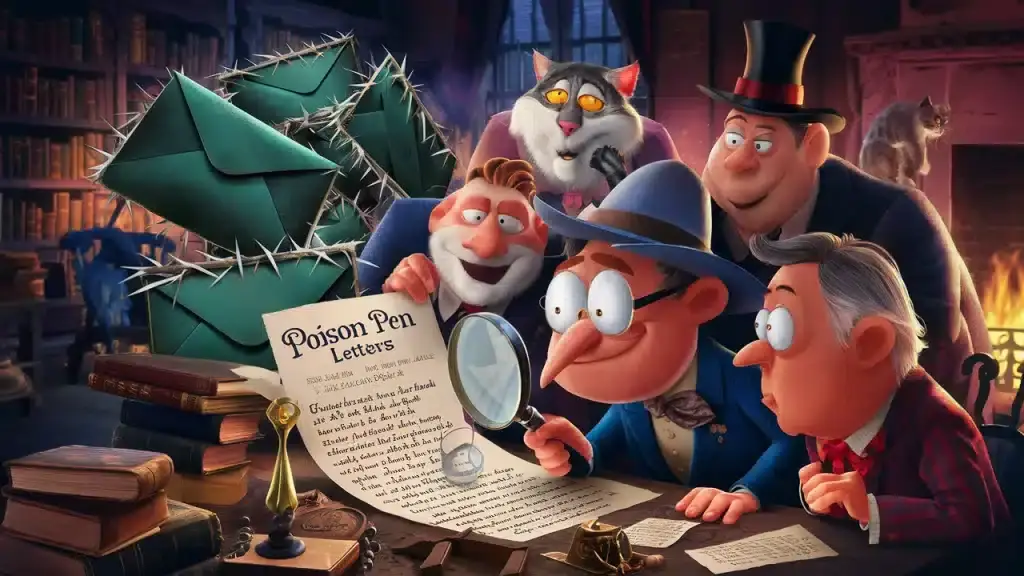The Poison Pen Letters: Imagine living in a quaint 1920s English seaside town where tranquility is suddenly shattered by a slew of venomous, anonymous letters filled with profanities.
This bizarre and disturbing scandal forms the backdrop of “Wicked Little Letters,” a new film featuring Olivia Colman. At the heart of the story is Edith Swann and Irish migrant Rose Gooding, whose lives turn chaotic due to these mysterious poison pen letters.

The term “poison pen letter” is not just a dramatic phrase; it refers to real-life letters brimming with malicious statements, typically sent anonymously.
In fact, this strange crime wave struck the early 20th century, leaving many feeling vulnerable and fearful.
One of the most infamous cases involved Edith Swan, who was later revealed as the true culprit behind the letters, despite Rose Gooding’s wrongful conviction. Detectives had to use clever tricks, like marking postage stamps with invisible ink, to catch the real sender.
The intrigue surrounding poison pen letters reveals more than just individual malice; it highlights the anxiety and suspicion that can ferment in small communities.
These letters, often dismissed as mere pranks, held the power to undermine trust and spread fear among neighbors.
The story of Swan and Gooding is not just a historical curiosity but a window into the darker corners of human nature.
Learn more about this bizarre phenomenon and the film “Wicked Little Letters” here.
The History of Poison Pen Letters
Anonymous letters filled with abuse and malice have intrigued and horrified societies for centuries. The origins date back to the early 20th century and these letters have influenced the media, leading to high-profile investigations and trials.
Origins and Social Impact
The term “poison pen letter” first popped up in the United States around 1911, thanks to a headline in the Maryland Evening Post.
Before long, it spread to Britain as well. These letters were often handwritten to conceal the sender’s identity, adding an eerie touch of mystery and menace.
They thrived in times of social tension, like the First World War. People would use these letters to sabotage reputations or stir chaos under the cloak of anonymity.
They created a societal uproar, affecting communities and sometimes leading to legal action.
Notable Historical Cases
One of the most infamous cases inspired the film Wicked Little Letters. The Littlehampton letters caused a national scandal and a legal battle. Emily Cockayne explored this case in her books Cheek by Jowl: A History of Neighbours and Penning Poison: A History of Anonymous Letters.
Another significant moment was in the early 1900s. Tracking down the culprits was tricky, as anonymity served as a powerful shield.
The media loved these scandals, further popularizing the term and adding to its infamy.
You can read more about this fascinating history on History Today.
Psychological Profile of Senders

Senders of poison pen letters, often driven by deep-seated emotions like anger and resentment, hide behind the veil of anonymity to unleash their venom. Understanding their motivations and the effects of anonymity sheds light on this troubling behavior.
Motivations Behind Malicious Letters
Malicious letters often stem from intense feelings. Individuals send these letters due to anger or jealousy. They might feel wronged and seek revenge.
Sometimes, it’s about power. Feeling powerless in real life, they use hate mail to exert control.
In some cases, stalkers resort to poison pen letters. They see it as a way to maintain an unsettling presence in the victim’s life.
Also, harassment fuels many of these messages. People use letters to manipulate or frighten others, deriving satisfaction from their distress.
These letters can escalate to more severe actions if unchecked.
The Impact of Anonymity on Behavior
Anonymity emboldens senders. They believe they won’t face consequences, so they express their darkest thoughts.
Hidden identity removes the fear of retribution, making them comfortable with their malicious words.
This anonymity creates a false sense of security. The individuals may start to feel invincible, leading to more frequent or aggressive letters.
Without accountability, their hate mail becomes more toxic. They can sustain long-term harassment, knowing they are protected by the veil of anonymity. This often leads to ongoing emotional harm for the receiver.
Legal Framework and Prosecution

When dealing with poison pen letters, the law is focused on ensuring justice is served through effective legislation. Several key acts and legal challenges help to prosecute these offenses, protecting victims and upholding the integrity of communication.
Communications Act 1988
The Communications Act 1988 plays a significant role in addressing poison pen letters. This act covers the misuse of public communication networks.
Specifically, sections of this law target the sending of grossly offensive or indecent messages, including poison pen letters which contain threats, blackmail, or libelous content.
Convictions under this act can result in hefty fines or even imprisonment, ensuring that justice is served, and offenders are held accountable.
Malicious Communications Act 1988
The Malicious Communications Act 1988 provides another critical framework for prosecuting poison pen letters.
This act makes it an offense to send a letter or any other communication with the intent to cause distress or anxiety.
Under this law, prosecutors need to show that the communication was malicious and intended to harass. Evidence such as the tone and content of the letter can be crucial here.
Successful prosecution under this act can lead to imprisonment or a fine, offering victims some peace of mind.
Modern Legal Challenges
Modern legal challenges add complexity to the prosecution of poison pen letters.
With the advent of digital communication, the legal system faces new hurdles in tracking and prosecuting offenders.
Although traditional mail remains an issue, emails and social media messages can also serve as modern poison pen letters.
Legal evidence must be meticulously gathered, whether tracking down IP addresses or securing digital copies of offensive messages.
Prosecutors often need to prove the intention behind the message, which can be tricky.
Moreover, defense strategies might focus on questioning the credibility of digital evidence, aiming to acquit the accused.
Cultural Depictions and Media Coverage

The fascination with poison pen letters has led to numerous cultural depictions in literature, film, and documentary formats. These stories often highlight the mysterious and scandalous nature of such letters, capturing public imagination.
Literature and Film
Poison pen letters have been featured in various literary works and films. A notable example is the book Penning Poison: A History of Anonymous Letters by Emily Cockayne, which delves into the sinister side of anonymous correspondence.
The film Wicked Little Letters, starring Olivia Colman and Jessie Buckley, draws inspiration from the true story of the Littlehampton letters.
This movie blends dark humor and suspense, showcasing how poison pen letters can unravel communities.
Enid Blyton’s The Mystery of the Spiteful Letters features young detectives solving the mystery of anonymous nasty notes. These stories show the ongoing intrigue and impact of poison pen letters in both fictional and real settings.
True Crime Stories and Documentaries
True crime stories often feature poison pen letters, highlighting their role in creating fear and uncertainty.
The case of the Littlehampton letters gripped the public’s attention, leading to a national uproar and a trial.
Documentaries and news articles have explored these letters’ impact on victims and communities.
Coverage by organizations like The New York Times often sheds light on the psychological and social implications of receiving venomous messages.
Dr. Emily Cockayne, whose research spans modern English history, significantly contributed to the understanding of this phenomenon. Her work helps to contextualize these letters within broader social and cultural histories.
Analyzing the Language of Poison Pen Letters
The language in poison pen letters was often threatening, using foul obscenities and inflammatory remarks. These letters were designed to provoke a strong emotional response from the recipients.
Linguistic Characteristics
Poison pen letters were filled with vulgar language. Writers often used slang and non-standard grammar to make the message more personal and aggressive.
These letters relied heavily on short, direct sentences to deliver their threats and insults quickly. This gave the letter a punchy, urgent tone.
Writers often used capital letters, underlining, or exclamation marks to emphasize their points. This helped make threats seem more immediate and serious.
Sometimes, the language included inside jokes or personal references, making it clearer that the writer knew the recipient well. This added to the shock value.
The Role of Foul Language and Obscenities
Foul language and obscenities played a key role in poison pen letters. The writer’s use of obscene words was not accidental; it was meant to catch the reader off guard.
Using obscene language helped the writer express extreme anger and frustration. It made the letter more shocking and memorable.
This was particularly effective in the early 20th century when public use of such language was less common.
Some letters used sexually explicit language or slurs to attack the recipient’s character. This was intended to shame and intimidate.
The use of such language showed a complete disregard for social norms, making the letter even more unsettling.
Incorporating obscenities made these letters more potent and damaging. Recipients often felt targeted on a deeply personal level, amplifying the hurt and fear caused by the letter.
Investigative Techniques and Forensic Handwriting

When investigating poison pen letters, authorities use various methods to trace the origins of the letters and analyze the handwriting for clues. These techniques help detectives and forensic experts identify the sender and gather crucial evidence.
Tracing the Origins of Letters
To catch the culprit behind poison pen letters, investigators start by examining the physical characteristics of the letters. They look at the paper, ink, and any other materials used.
Sometimes, even tiny details like the type of stamp or envelope can offer critical hints.
Police, like those at Scotland Yard, often collaborate with postal services to track the route the letter took.
They may analyze postmarks or unique barcodes to determine where the letter was sent from and possibly narrow down suspects. Collaboration with various agencies can be quite effective in pinpointing the sender’s location.
Digital forensic techniques also play a role. Handwritten scans might reveal pressure patterns or unique characteristics that link letters to the same author.
Each letter brings clues that, when pieced together, can lead investigators to the culprit.
The Evolution of Forensic Methods
Over the years, forensic handwriting analysis has grown more sophisticated.
In the past, graphologists would rely heavily on visual comparisons to identify writing traits. Characteristics like the slant, size, and shape of letters were major focal points.
Today, forensic handwriting experts use technology to enhance their work.
Specialized software analyzes and compares handwriting samples with great precision. These tools can pick up minute details that the human eye might miss.
Scotland Yard and other police forces now use these advanced methods to strengthen their investigations.
Despite some skepticism around graphology, modern techniques make handwriting analysis more reliable.
By combining traditional methods with advanced technology, police are able to gather more conclusive evidence, aiding in solving crimes involving poison pen letters.
Steve is the creative force behind Unique Tales, a blog dedicated to sharing captivating stories that explore the human experience in all its complexity. With a passion for writing and a talent for crafting engaging narratives, Steve's blog is a treasure trove of imaginative tales that transport readers to other worlds and challenge them to see things from new perspectives. From epic adventures to intimate character studies, Steve's stories are always thought-provoking and emotionally resonant. With a growing following of readers who appreciate his unique voice and creative vision, Steve is quickly becoming a rising star in the world of online storytelling.






